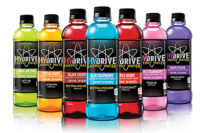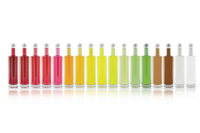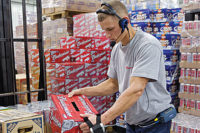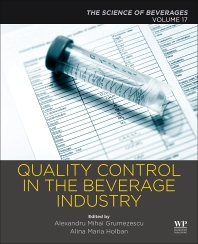Whether red, brown or blue, beverage colors play a large role in impacting consumers’ perceptions of a product. A March 2013 study by D.D. Williamson, Louisville, Ky., further illuminated this concept by presenting 24 test subjects with clear, brown and pink versions of a lemon-lime-flavored carbonated beverage.
When presented as a clear soft drink, 81 percent of subjects correctly identified the product as having a lemon-lime or citrus flavor. However, when the drink was colored brown, 34 percent of participants described it as “sweet” or “fruity,” while 15 percent described it as having a cola flavor. Likewise, when it was colored pink, 38 percent of respondents described it as “fruity,” “berry” or “sweet.” In addition, the majority of respondents said they enjoyed the pink beverage best, citing that it was the most flavorful and visually appealing. Many of these perception differences were influenced solely by the beverage’s color.
“The color of a beverage affects the consumer’s perception of taste as we drink with our eyes,” explains Jody Renner-Nantz, global application scientist for D.D. Williamson. “Color is a clue to flavor. For example, red-colored drinks are typically associated with sweetness — such as strawberry or cherry flavors. By contrast, yellow-colored drinks are associated with sour flavors like lemon. Green is perceived as tart in flavor, such as apple or lime.”
Consequently, if a beverage-maker chooses the wrong color for a beverage, the perception can be skewed, says Dave Tuescher, technical director for Sethness, Lincolnwood, Ill. For example, Esquire magazine’s Eat Like a Man Blog described green beer as “disgusting,” even though the green food coloring added to the beer does not impact the taste, according to its March 14 article “Can Green Beer be Great Beer?”
For this reason, when working with customers to select a color for a beverage, Food Ingredient Solutions LLC considers the flavor profile of the beverage product as well, says Jeff Greaves, president of the Rohnert Park, Calif.-based company. This can even come down to choosing a specific shade within a color range, like selecting a strawberry red versus a fruit punch red to appropriately match the flavor, he says.
Beverage-makers also consider what consumers want when choosing a color scheme. “Consumers are mainly attracted to well-known and natural-looking colors found in beverages,” explains Christian Benetka, senior product manager for Döhler Group, Darmstadt, Germany. For example, colors such as red, orange, yellow and brown are commonly found in nature in fruits and vegetables, he says. These colors also happen to be the most popular beverage colors, he notes. On the other hand, bright colors in a beverage can help to attract attention and appeal to children who are seeking a product that is interesting and different, he adds.
Natural benefits
Health-conscious consumers are calling for naturally colored beverages, says Chad Ford, associate director of colors for Wild Flavors Inc., Erlanger, Ky. “Many consumers associate health benefits with sources of naturally derived colors,” he says. “Often natural colors are free of [genetically modified organisms] (GMOs) and allergens.” In addition, natural colors help to create a clean label, and their sources can be listed on the label to help explain what the ingredient is and what its use is, he adds. For example, purple carrot juice can be listed as “purple carrot juice (color),” he explains.
Plus, because they are derived from fruit and vegetable sources, such colors are frequently approved and accepted by most international regulatory bodies and retailers, says Kelly Newsome, corporate communications manager for GNT USA Inc., Tarrytown, N.Y. “Most importantly, consumers across the globe can easily recognize and feel safe consuming color ingredients made from fruits and vegetables,” she says. In this way, the use of natural colors can help beverages expand into new and international markets.
In order to formulate with natural colors, beverage-makers are willing to invest a little more money in their coloring solutions to make consumers happy, notes Tracy Takeda, product development technologist for San Joaquin Valley Concentrates, Fresno, Calif. “Artificial colors are usually less expensive than natural [colors], but formulators are willing to pay a little more for natural colors to gain consumers’ positive perceptions,” she says.
Chicago-based Mintel reported at this year’s Institute of Food Technologists (IFT) Annual Meeting and Food Expo that natural colors have been on the rise in the last few years. In fact, natural colors have experienced 77 percent growth since 2009, reported Lynn Dornblaser, director of innovation and insight at Mintel, during the market research firm’s IFT presentation.
Coloring in harmony
Despite their popularity, natural colors do pose some formulation challenges, including stability issues. According to D.D. Williamson’s 2013 IFT poll, pH is the No. 1 stability challenge when working with natural colors in a new beverage. Industry technologists polled also noted heat, light, distribution, interaction with other components, and solubility as other challenges.
Lack of stability in a beverage can cause colors to fade, stain the bottle, or ring, says Byron D. Madkins, senior director of product development and applications for colors at Chr. Hansen Inc., Milwaukee. Ringing occurs when an emulsion or encapsulation of an oil-based pigment is disrupted or broken. In the case of beta carotene, which provides yellow to orange hues, the color visibly separates from the solution and floats on top, he explains. This is undesirable and does not communicate quality to a potential consumer, he adds.
These stability issues also translate into shelf-life challenges, Madkins says. Ensuring that Chr. Hansen’s colors survive a nine- to 12-month shelf-life is one of the company’s biggest formulation challenges and takes up to 80 percent of its time, he notes. To further address this issue, the company’s laboratories conduct real-time and accelerated stability testing to demonstrate what a given beverage with its colors would look like in the first, fifth, ninth and 12th month after production, he says. With this data, the company is able to recommend the best color formulation options for a specific beverage type, he adds.
Through an understanding of these stability issues, beverage formulators also have designed color systems and formulations to handle these challenges. For example, formulators can take advantage of co-pigmentation, or the way in which colors interact, to create a more stable color system, Madkins says. They also can utilize micro-encapsulation by putting oil-based or insoluble pigments into a matrix with sugar and hydrocolloids to create water-dispersible color systems that can uniformly color the beverage, he says.
Emulsion technology also can help with color stability in a beverage, according to Cory Gegg, marketing manager for Sensient Colors LLC, St. Louis. Sensient recently launched its advanced emulsion technology, which uses complex, water-based emulsions to allow multiple oil- and water-based natural colors to co-exist in a single color system, he says. This technology also can help to prevent package staining, allow for lower color usage levels, and minimize off-notes that are sometimes associated with natural colors, he adds.
Many of these formulation challenges also can be skirted by opting for artificial colors, Food Ingredient Solutions’ Greaves says. “Most artificial colors can be used in most systems without much concern about the matrix,” he says. In addition, artificial colors easily blend into most beverages because they rarely react with other ingredients, Döhler’s Benetka says.
Red hot
Whether artificial or natural, red hues are the top trending color for beverages, experts note. These hues are mostly made of carmine or anthocyanins such as purple sweet potato, red cabbage, red radish, black or purple carrot, elderberry and grape, according to Food Ingredient Solutions’ Greaves.
San Joaquin Valley Concentrates produces its natural red colors from Rubired grapes sourced from contracted farmers and purple carrots and sweet potatoes from Food Safety System Certification 22000-certified suppliers, Takeda says.
A recent challenge due to natural red’s popularity in a variety of beverages has been to create pigments that are stable in the presence of vitamin C, D.D. Williamson’s Renner-Nantz says. To overcome this, the company blended several different anthocyanins to create a red color that meets both hue and stability targets for vitamin-enhanced waters, she says.
Brown is the new black
The color brown recently garnered the second-most popular beverage color spot, surpassing yellow and orange, according to Renner-Nantz. In 2013, D.D. Williamson tracked a relative increase in new beverages that are brown and a relative decrease in those that are yellow, she says.
Although brown often is assoc-iated with chocolate or caramel flavors in the food industry, in the beverage industry, with the exception of dairy drinks, the color is commonly associated with cola and root beer flavors, Chr. Hansen’s Madkins says.
Beverages, including carbonated soft drinks, teas, beers, whiskies, energy drinks, protein drinks and fruit juice drinks, tend to be the No. 1 use for caramel colors among all product categories, according to Sethness’ Tuescher. The company offers 60 different liquids in varying shades of brown, including colors as light as red and yellow, he says. To choose one of these shades and liquids, Sethness talks to customers about what they are trying to accomplish with the color.
Factors like desired level of 4-Methylimidazole, ionic charge, pH and other elements of the beverages’ conditions also are taken into account to find the appropriate solution. “For example, if you have a root beer, … you [need] a caramel color that foams,” Sethness’ Tuescher explains. “If you have a soda, you need a caramel color that does not foam. … If you have alcohol, like a whiskey, you need to have a caramel color that will tolerate the alcohol without precipitating.”
From a formulation standpoint, caramel colors are very water-soluble, Tuescher says. Caramel colors also help create batch consistency and uniformity within a beverage line, because beverage formulators can add a little bit of caramel color to make sure the shades of different batches look uniform on the shelf, he adds.
Bright and eye-catching
Yellow and orange hues still are popular in the United States and also are the top trending colors in Spain, according to Food Ingredient Solutions’ Greaves. These colors tend to come from sources such as beta-carotene, apo-carotenal, Yellow No. 5 and Yellow No. 6, he says.
Most yellow and orange color sources are oil-based, which can present a challenge in beverage formulations, Döhler’s Benetka says. Oftentimes, beverage-makers use emulsion technology to incorporate these colors, but that sometimes results in a cloudy appearance, he notes. Döhler took this technology one step further by using advanced emulsion technology to produce its Crystal Clear Colours portfolio based on carotenoids. The result is easy-to-use and highly stable “warm orange” and “shining yellow” hues for alcohol and non-alcohol beverages, he says.
To create high-intensity yellow and orange colors, LycoRed Ltd., Israel, recently developed its Lyc-O-Beta Intense and BetaCote color portfolios. These solutions offer higher color intensity compared with other beta-carotene colorants and, in turn, require lower colorant usage, the company says. In addition, the colors are non-foaming, resistant to the fading that can occur as a result of pasteurization and other stressful processes, and highly soluble for easy formulation, it says.
Feeling blue
Creating natural blues, greens and purples has historically been a challenge for color-makers, experts note. However, through advancements in the understanding of natural colors, the color industry has created stable, natural blues for use in beverages.
Five years ago, Wild Flavors launched its acid-stable natural blue color derived from fruit. Suitable for alcohol and non-alcohol beverages, the blue color additive is stable within a pH range of 2.5 and 8.0 and can serve as a foundation for green and purple colors, the company says.
Adding to the color options in the market, Sensient Colors launched this year a new line of clean-label, bright and stable blues, greens and purples for use in food and beverages in the United States. Derived from proprietary sources, the natural platform can replicate bold shades of artificial colors ranging from blueberry to sky blue, vibrant emerald green to clean mint green, and intense grape to soft pastel lavender, Gegg says.
Even more blue, green and purple color options may be available in the near future. This year, the FDA approved Spirulina, a pigment derived from algae that delivers bright blue and green shades, for use as a food colorant in candy and chewing gum. Although use of this colorant currently is limited, experts note that future consideration could open this source to use in the beverage industry.










